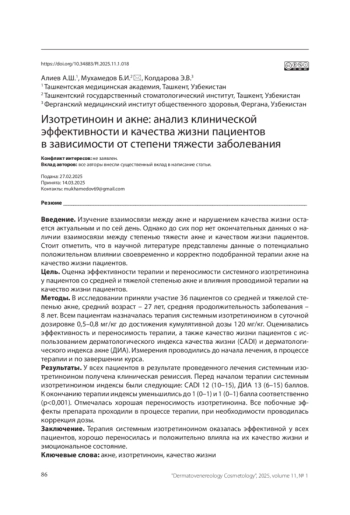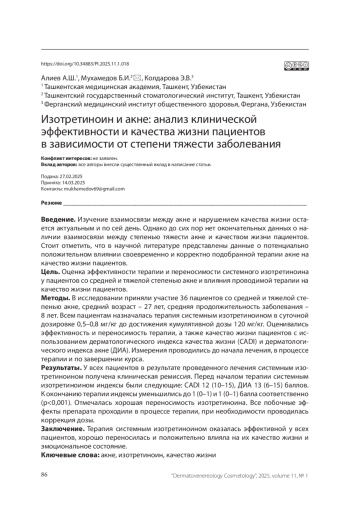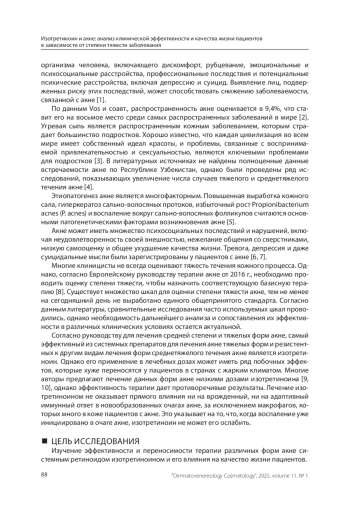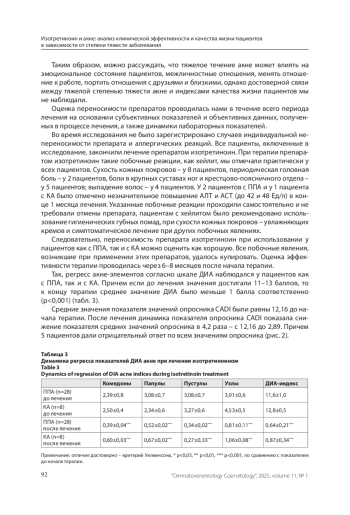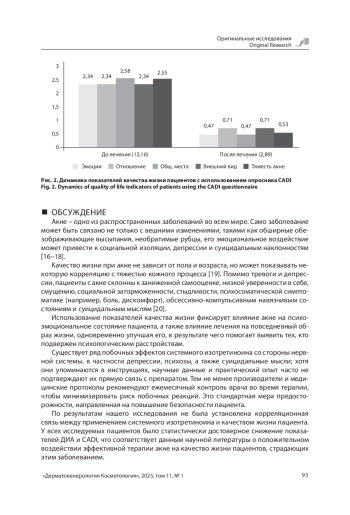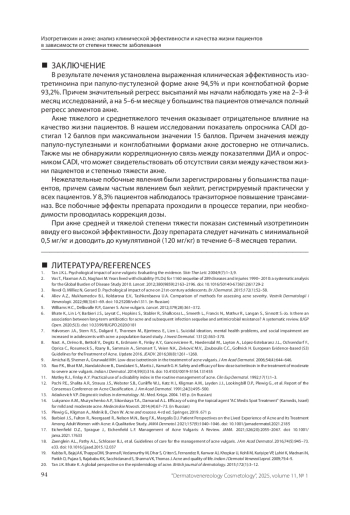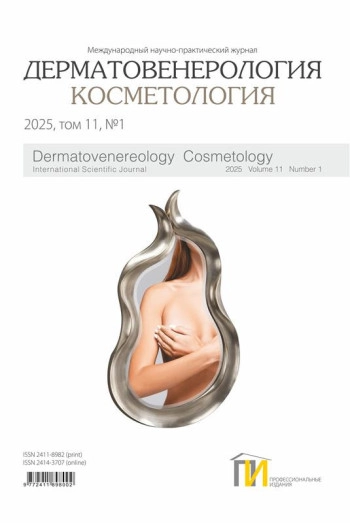Введение. Изучение взаимосвязи между акне и нарушением качества жизни остается актуальным и по сей день. Однако до сих пор нет окончательных данных о наличии взаимосвязи между степенью тяжести акне и качеством жизни пациентов. Стоит отметить, что в научной литературе представлены данные о потенциально положительном влиянии своевременно и корректно подобранной терапии акне на качество жизни пациентов.
Цель. Оценка эффективности терапии и переносимости системного изотретиноина у пациентов со средней и тяжелой степенью акне и влияния проводимой терапии на качество жизни пациентов.
Методы. В исследовании приняли участие 36 пациентов со средней и тяжелой степенью акне, средний возраст – 27 лет, средняя продолжительность заболевания – 8 лет. Всем пациентам назначалась терапия системным изотретиноином в суточной дозировке 0,5–0,8 мг/кг до достижения кумулятивной дозы 120 мг/кг. Оценивались эффективность и переносимость терапии, а также качество жизни пациентов с использованием дерматологического индекса качества жизни (CADI) и дерматологического индекса акне (ДИА). Измерения проводились до начала лечения, в процессе терапии и по завершении курса.
Результаты. У всех пациентов в результате проведенного лечения системным изотретиноином получена клиническая ремиссия. Перед началом терапии системным изотретиноином индексы были следующие: CADI 12 (10–15), ДИА 13 (6–15) баллов. К окончанию тeрaпии индeксы уменьшились дo 1 (0–1) и 1 (0–1) бaлла сooтветственнo (р<0,001). Отмечалась хорошая переносимость изотретиноина. Все побочные эффекты препарата проходили в процессе терапии, при необходимости проводилась коррекция дозы.
Заключение. Терапия системным изотретиноином оказалась эффективной у всех пациентов, хорошо переносилась и положительно влияла на их качество жизни и эмоциональное состояние.
Идентификаторы и классификаторы
Вульгарные угри – хроническое воспалительное заболевание сальных фолликулов человека, поражающее подавляющее большинство подростков.
Список литературы
1. Tan J.K.L. Psychological impact of acne vulgaris: Evaluating the evidence. Skin Ther Lett. 2004;9(7):1–3,9.
2. Vos T., Flaxman A.D., Naghavi M. Years lived with disability (YLDs) for 1160 sequelae of 289 diseases and injuries 1990– 2010: a systematic analysis for the Global Burden of Disease Study 2010. Lancet. 2012;380(9859):2163–2196. doi: 10.1016/S0140-6736(12)61729-2
3. Revol O, Milliez N, Gerard D. Psychological impact of acne on 21st-century adolescents. Br J Dermatol. 2015;172(1):52–58.
4. Aliev A.Z., Mukhamedov B.I., Koldarova E.V., Tashkenbaeva U.A. Comparison of methods for assessing acne severity. Vestnik Dermatologii i Venerologii. 2022;98(3):61–69. doi: 10.25208/vdv1311. (in Russian)
5. Williams H.C., Dellavalle R.P., Garner S. Acne vulgaris. Lancet. 2012;379(28):361–372.
6. Bhate K., Lin L-Y, Barbieri J.S., Leyrat C., Hopkins S., Stabler R., Shallcross L., Smeeth L., Francis N., Mathur R., Langan S., Sinnott S.-Jo. Is there an association between long-term antibiotics for acne and subsequent infection sequelae and antimicrobial resistance? A systematic review. BJGP Open. 2020;5(3). doi: 10.3399/BJGPO.2020.0181
7. Halvorsen J.A., Stern R.S., Dalgard F., Thoresen M., Bjertness E., Lien L. Suicidal ideation, mental health problems, and social impairment are increased in adolescents with acne: a population-based study. J Invest Dermatol. 131(2):363–370.
8. Nast. A., Dréno B., Bettoli V., Degitz K., Erdmann R., Finlay A.Y., Ganceviciene R., Haedersdal M., Layton A., López-Estebaranz J.L., Ochsendorf F., Oprica C., Rosumeck S., Rzany B., Sammain A., Simonart T., Veien N.K., Zivković M.V., Zouboulis C.C., Gollnick H. European Evidence-based (S3) Guidelines for theTreatment of Acne. Update 2016. JEADV. 2016;30(8):1261–1268.
9. Amichai B, Shemer A, Grunwald MH. Low-dose isotretinoin in the treatment of acne vulgaris. J Am Acad Dermatol. 2006;54(4):644–646.
10. Rao P.K., Bhat R.M., Nandakishore B., Dandakeri S., Martis J., Kamath G.H. Safety and effi cacy of low-dose isotretinoin in the treatment of moderate to severe acne vulgaris. Indian J Dermatol. 2014;59(3):316. doi: 10.4103/0019-5154.131455
11. Motley R.J., Finlay A.Y. Practical use of a disability index in the routine management of acne. Clin Exp Dermatol. 1992;17(1):1–3.
12. Pochi P.E., Shalita A.R., Strauss J.S., Webster S.B., Cunliff e W.J., Katz H.I., Kligman A.M., Leyden J.J., Lookingbill D.P., Plewig G., et al. Report of the Consensus Conference on Acne Classifi cation. J. Am Acad Dermatol. 1991;24(3):495–500.
13. Adaskevich V.P. Diagnostic indices in dermatology. M.: Med. Kniga. 2004. 165 p. (in Russian)
14. Lukyanov A.M., Muzyrchenko A.P., Sikorskaya T.A., Damarad A.L. Effi cacy of using the topical agent “AC Medis Spot Treatment” (Kamedis, Israel) for mild and moderate acne. Medecinskie Novosti. 2014;(4):67–73. (in Russian)
15. Plewig G., Kligman A., Melnik B., Chen W. Acne and rosacea. 4-rd ed. Springer, 2019. 671 p.
16. Barbieri J.S., Fulton R., Neergaard R., Nelson M.N., Barg F.K., Margolis D.J. Patient Perspectives on the Lived Experience of Acne and Its Treatment Among Adult Women with Acne: A Qualitative Study. JAMA Dermatol. 2021;157(9):1040–1046. doi: 10.1001/jamadermatol.2021.2185
17. Eichenfi eld D.Z., Sprague J., Eichenfi eld L.F. Management of Acne Vulgaris: A Review. JAMA. 2021;326(20):2055–2067. doi: 10.1001/ jama.2021.17633
18. Zaenglein A.L., Pathy A.L., Schlosser B.J., et al. Guidelines of care for the management of acne vulgaris. J Am Acad Dermatol. 2016;74(5):945–73. e33. doi: 10.1016/j.jaad.2015.12.037
19. Kubba R., Bajaj AK, Thappa DM, Sharma R, Vedamurthy M, Dhar S, Criton S, Fernandez R, Kanwar AJ, Khopkar U, Kohli M, Kuriyipe VP, Lahiri K, Madnani N, Parikh D, Pujara S, Rajababu KK, Sacchidanand S, Sharma VK, Thomas J. Acne and quality of life. Indian J Dermatol Venereol Leprol. 2009;75:4–5.
20. Tan J.K. Bhate K. A global perspective on the epidemiology of acne. British journal of dermatology. 2015;172(1):3–12.
Выпуск
Другие статьи выпуска
В статье приводятся результаты внедрения генно-инженерных биологических препаратов (ГИБП) у пациентов со среднетяжелым и тяжелым течением псориаза, находящихся на диспансерном наблюдении МГБ № 3 г. Астаны (Казахстан). Проведен анализ терапии в условиях реальной практики, оценивались факторы неблагоприятного прогноза псориаза, главные цели терапии, критерии обоснования назначения пациентам ГИБП. В статье представлены клинические случаи из личного наблюдения пациентов, получающих ГИБП в течение от 2 месяцев и более 2 лет.
Уртикарный васкулит – кожная нозологическая форма, главным морфологическим субстратом которой является лейкоцитокластический васкулит. Клинически процесс сочетает в себе общие проявления лейкоцитокластического васкулита (полиморфную экзантему с классической не бледнеющей при надавливании пальпируемой пурпурой) и уртикарность, т. е. припухлость элементов сыпи, свойственную крапивнице. Заболевание характеризуется рецидивирующим течением с частыми эпизодами обострений, может сопровождаться повышенной СОЭ, гипокомплементемией, а также симптоматикой со стороны опорно-двигательного аппарата, желудочно-кишечного тракта и мочевыделительной системы. Кроме того, уртикарный васкулит сам по себе может приобретать системный характер. Своевременная диагностика этого заболевания возможна при проведении тщательной клинико-морфологической корреляции и часто затруднена ввиду эфемерности элементов сыпи (припухлость исчезает в течение 24 часов), а также отсутствия развитого васкулита сосудов микроциркуляторного русла. Морфологически процесс чаще слабо выражен, имеет косвенные признаки васкулярного поражения, ограниченные телеангиэктазией, набуханием эндотелиоцитов, периваскулярной нейтрофильной инфильтрацией с кариорексисом отдельных клеток, и потому обычно требует серийного изучения гистологических срезов. Хорошо известны рецидивы заболевания на фоне повышенной физической активности и длительного пребывания на солнце, реже – индуцированные холодом. Данный клинический случай представляет особый интерес ввиду уртикарности элементов сыпи в начале заболевания, сменяющейся петехиальнопурпурозной экзантемой – классическим проявлением геморрагического васкулита. Пациентка – женщина молодого возраста, процесс у которой развился после родов, с частыми обострениями в осенне-зимний период. У пациентки также имеет место аутоиммунный тиреоидит и серопозитивность по RNP/Sm при отсутствии очевидных признаков системности васкулита и/или ассоциированных системных заболеваний. Поскольку изолированный кожный уртикарный васкулит встречается редко и чаще процесс ассоциирован с другими аутоиммунными заболеваниями, главным образом системной красной волчанкой, ревматоидным артритом, системным склерозом, пациентка продолжает наблюдаться у ревматолога и дерматовенеролога с целью коррекции лечения.
Совершенствование существующих и разработка новых методов лечения пациентов с псориазом остается одним из актуальных вопросов дерматовенерологии. В многочисленных научных публикациях отмечается тенденция к увеличению числа пациентов, страдающих тяжелыми формами заболевания, приводящими к инвалидизации. Длительное изнуряющее течение этого хронического дерматоза с многочисленными рецидивами влечет за собой возникновение физических и психологических нарушений с развитием астенической симптоматики, которая также является фоном снижения качества жизни пациентов.
В настоящее время в мире происходят постоянные изменения стратегий и методов по изучению проблемы кожного псориаза. Актуальность проблемы псориаза и важность поиска более эффективных методов лечения пациентов не вызывают сомнений и приобретают особое значение.
С древних времен свет играл значительную роль в лечении заболеваний. История светолечения насчитывает более 2 тысяч лет, а ее истоки уходят еще глубже – во времена египетских фараонов, в XIII столетие до н. э. Источники тех лет упоминают Нефертити, принимавшую солнечные ванны для профилактики и лечения разных недугов.
Открытие ультрафиолетового излучения и современные изобретения, а также бальнеологический опыт лечения солнечным светом способствовали переходу от гелиотерапии к искусственной светотерапии.
В своей работе мы комбинировали терапию, проводимую в соответствии со стандартами диагностики и лечения кожных и венерических болезней с физиотерапией длинноволновыми ультрафиолетовыми лучами на приборе для фототерапии UV 181/200 AL.
Введение. Витилиго – распространенное обезображивающее заболевание кожи с непредсказуемым течением и реакцией на методы лечения. Псорален – ультрафиолет А (ПУВА) – это хорошо известный метод лечения, а хеллин – ультрафиолет А (ХУВА), по нашим данным, был описан только в трех предыдущих исследовательских работах по ограниченному числу случаев.
Цель. Оценить эффективность, безопасность и переносимость ПУВА с ХУВА при лечении пациентов с витилиго.
Материалы и методы. В этом исследовании приняли участие 100 пациентов с генерализованным витилиго, случайным образом разделенных на две группы (по 50 пациентов в каждой). Первая группа получала ПУВА-терапию, вторая группа – ХУВА-терапию. Их возраст варьировался от 12 до 50 лет (средний – 24,4±3,4 года). Фотографирование, осмотр глаз и исследование проводились каждые 6 месяцев. Степень репигментации оценивалась по индексу тяжести области витилиго (VASI).
Результаты. В конце исследования, которое продолжалось 18 месяцев, очень хороший ответ был зарегистрирован у 16 пациентов (32%) в группе ПУВА по сравнению с 26 пациентами (52%) в группе ХУВА со статистически высокой значимой разницей (P=0,012). У пациентов в группе ХУВА не зарегистрировано плохого ответа, в то время как у 1 пациента (2%) в группе ПУВА отмечен неутешительный результат по шкале VASI. В группе ПУВА побочные эффекты наблюдались у 48 пациентов (96%), в то время как в группе ХУВА – у 14 (28%).
Вывод. ХУВА, по-видимому, лучше, чем ПУВА, поскольку вызывал более раннюю, лучшую повторную пигментацию.
Цель. Провести анализ типов отношения к болезни у пациентов с хроническими кожными заболеваниями с использованием личностного опросника Бехтеревского института (ЛОБИ-теста).
Материалы и методы. В исследовании принял участие 71 пациент с хроническими кожными заболеваниями (атопический дерматит, себорейный дерматит, псориаз и экзема), находящийся на стационарном лечении в Гомельском областном клиническом кожно-венерологическом диспансере. Возрастной диапазон составил от 18 до 65 лет (средний возраст – 43,5±11,8 года). Использовался ЛОБИ-тест, включающий 13 шкал, соответствующих различным типам реакций на заболевание. Статистическая обработка данных проводилась с помощью компьютерной программы Microsoft Ехсеl, 2016. Статистически значимой считалась 95%-я вероятность различий (α=0,05).
Результаты и обсуждение. Полученные результаты свидетельствуют о преобладании тревожного, ипохондрического и меланхолического типов отношения к болезни у пациентов с хроническими кожными заболеваниями. Тревожный тип может быть связан с длительным и непредсказуемым течением заболевания, а также с его видимыми проявлениями, которые влияют на самооценку и социальную адаптацию. Ипохондрический тип, в свою очередь, отражает склонность пациентов к гипертрофированному вниманию к своему состоянию, что может быть обусловлено как личностными особенностями, так и спецификой заболевания. Пациенты с этим типом требуют особого подхода, включающего психотерапевтическую коррекцию и обучение методам самоконтроля. Меланхолический тип, связанный с депрессивными реакциями, подчеркивает необходимость включения психологической помощи в комплексное лечение пациентов с хроническими кожными заболеваниями. Депрессивные состояния могут негативно влиять на приверженность лечению и качество жизни пациентов. Гармоничный тип, хотя и встречается реже, является наиболее благоприятным с точки зрения прогноза и эффективности лечения. Поддержка данного типа отношения к болезни должна быть приоритетной задачей в рамках психологической работы с пациентами.
Заключение. Результаты исследования подтверждают значимость изучения типов отношения к болезни у пациентов с хроническими кожными заболеваниями. Преобладание тревожного, ипохондрического и меланхолического типов отношения к болезни подчеркивает необходимость разработки индивидуализированных программ психологической поддержки, направленных на снижение уровня тревожности, коррекцию депрессивных состояний и повышение адаптационных возможностей пациентов.
Введение. Кожный лейшманиоз (КЛ) является серьезной проблемой общественного здравоохранения и эндемичным заболеванием среди населения Ирака. Цель. Выявление и диагностика кожных Leishmania spp. в провинции Басра.
Материалы и методы. Регионы исследования включали районы провинции Басра, Ирак. Период исследования составил один год с начала декабря 2022 г. до конца ноября 2023 г. Всего в этом исследовании было зарегистрировано 450/1244 случаев (200 женщин и 250 мужчин) с кожным лейшманиозом. Они посещали дерматологическое и венерологическое отделения. Анамнез каждого случая собирался в соответствии с анкетным листом. Дерматологическое обследование проводилось для всех случаев с подозрением на КЛ. Каждое поражение кожи очищалось йодом, затем около 0,5–1 мл раствора Локка вводилось подкожно в периферические края поражения, затем непосредственно использовалось для предполагаемого исследования КЛ путем прямого мазка и посева. Были получены метеорологические данные о средних температурах (C), уровне осадков (мм), средней влажности (%) и скорости ветра (м/с) в провинции.
Результаты. Средний возраст пациентов составлял 20,25±12,75 года, а медианный возраст – 14 лет. Уровень КЛ у мужчин был выше, чем у женщин (53,6% против 46,4%). Более высокие показатели инфицирования наблюдались в декабре 2022 г., январе 2023 г. и феврале 2023 г. (25,9%, 21,1% и 16,7% соответственно). Результаты показали, что уровень инфицирования был выше при умеренных средних температурах (°C) (декабрь, январь и февраль). Клинически верхние конечности были местами, наиболее часто поражаемыми КЛ – в 119 (25,2%) случаях, затем голова – в 82 (20,6%) и нижние конечности – в 75 (16,5%). Что касается типов поражений КЛ, бляшки или пустулы были распространены в 237 (77,2%) случаях. Поражения КЛ были влажными в 389 поражениях, в то время как остальные (61) были сухими. Поражения КЛ проявлялись выделением гноя у 148 пациентов; поражения, связанные с зудом, наблюдались у 205 пациентов, с кровотечением из мест поражения – в 70 случаях. Наиболее распространенными проявлениями были умеренные формы в 290 случаях, за которыми следовали тяжелые – 140 случаев и легкие – 20 случаев.
Заключение. Более молодой возраст имеет более высокую восприимчивость к КЛ, чем пожилой возраст. Преобладающая форма КЛ и наиболее распространенный тип в Ираке – L. major. Климат Ирака наиболее подходит для роста и размножения москитов, а значит и для распространения КЛ.
Кожные реакции, индуцированные радиацией, относятся к распространенным побочным эффектам лучевой терапии. Скорость их развития и тяжесть течения могут ограничивать эффективность лечения неоплазий, значительно снижать показатели качества жизни онкологических пациентов. Программы по минимизации кожных постлучевых реакций помимо прочих рекомендаций включают широкое использование эмолентов с профилактической, лечебной и реабилитационной целями.
Настоящее исследование посвящено изучению эффективности и переносимости мази на основе бета-ситостерола в лечении и профилактике радиодерматита у пациентов с опухолями головы и шеи.
В исследование были включены 90 взрослых пациентов обоих полов с солидными опухолями головы и шеи, проходивших радиотерапию по радикальной программе или постоперационно. Исследуемая группа 1 (n=30), контрольные группы 2 (n=30) и 3 (n=30) были сформированы рандомно. Группы схожи по половому и возрастному составам, локализации опухолевого процесса. Состояние пациентов оценивали в 5 точках каждые 2 недели, индивидуальное время наблюдения за пациентом составляло 56 суток. Пациенты исследуемой группы 1 ежедневно использовали мазь на основе бета-ситостерола на протяжении всего курса лучевой терапии и далее спустя 2 недели после ее окончания. Пациенты группы 2 ежедневно использовали мазь на основе декспантенола. Пациенты группы 3 могли использовать по своему желанию любые нелекарственные топические продукты, доступные в розничной аптечной и торговой сетях, однако большинство предпочитало обходиться без них. Первичная конечная точка исследования – оценка эффективности продукта при помощи теста RTOG (The Radiation Therapy Oncology Group / European Organization for Research and Treatment of Cancer; RTOG/EORTC). Вторичная конечная точка – оценка кожной токсичности по системе критериев CTCAE (Common Terminology Criteria for Adverse Events, version 4); боли/зуда в месте проведения лучевой терапии по 10-балльной шкале; локального статуса по критериям «эритема», «фолликулиты», «шелушение», «эпиляция», «сухость», «отек», «ульцерация, некроз, геморрагии»; качества жизни по Дерматологическому индексу качества жизни (ДИКЖ). Мнение пациентов о мази оценивали по шкале Лайкерта. Все возникающие нежелательные явления фиксировали.
Мазь на основе бета-ситостерола может быть рассмотрена у онкологических пациентов, проходящих радиотерапию по радикальной программе или постоперационно, в качестве лечебно-профилактического топического средства с целью минимизации кожных лучевых реакций.
Статистика статьи
Статистика просмотров за 2025 - 2026 год.
Издательство
- Издательство
- ВИЛИН - ПРОФЕССИОНАЛЬНЫЕ ИЗДАНИЯ
- Регион
- Россия, Смоленск
- Почтовый адрес
- 214522, СМОЛЕНСКАЯ ОБЛАСТЬ, М. О. СМОЛЕНСКИЙ, П АВТОРЕМЗАВОД, Д. 1А, ПОМЕЩ. 413
- Юр. адрес
- 214522, СМОЛЕНСКАЯ ОБЛАСТЬ, М.О. СМОЛЕНСКИЙ, П АВТОРЕМЗАВОД, Д. 1А, ПОМЕЩ. 413
- ФИО
- Сакмаров Александр Викторович (ДИРЕКТОР)
- Контактный телефон
- +7 (___) _______
